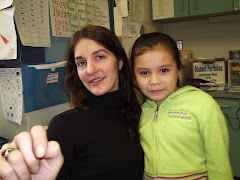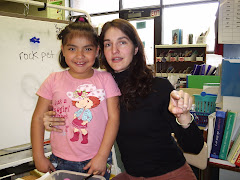.jpg)
As an ESL teacher, I go into various classrooms throughout the day. Thus, I interviewed six third grade students situated in three separate classrooms.
One male and two female were of African American origin. Two male and one female were of Latino origin. (These students have been living in the United States for no less than three years. Their language skills are advanced.)
Interview:
When asked what technology meant to them, all students related technology to the use of computers. Two of the African American students also added watching T.V. and the use of “electronic stuff” as technology equipment that play an important role in their lives. For the three Latino students, the importance of technology is stressed mostly at school, while for the African American students, technology is also emphasized at home. All students mentioned that the only place where they actually use technology in school is during specials, which is the designated time where students go to the computer lab and is taught by the technology teacher. The students expressed that they never use computers or other technology equipment in their regular classroom. They notice that technology exists in their classroom like computers; however, the technology equipment is hardly ever used. When asked what they do on the computer at school, answers varied from writing papers, surfing the Internet and/or playing games. A common game students play during specials is called Hot Wheels. This is a game where students “drive” cars. It appears to have no educational value.
The three African American students have at least one computer and other various technology equipment at home and in their rooms. All three Latino students do not have computers at home. When asked if their parents use technology, the three African American students said that their parents use computers for research, shopping, and various forms of communication. The Latino students’ parents do not use computers at all. When asked when and where they learned how to use computers, the African American students say they learn from their parents and in school whereas the Latino students said they learned about computers only in school during specials.
I noticed that the reaction to technology differed among male and female students. Male students expressed that technology was fun. They mostly talked about playing games. The two Latino boys, when questioned what they wished they had at school or at home in relation to technology, expressed that they wish they had their own computer. The female students did not express much enthusiasm. In fact, the female students seemed indifferent to technology. One female said that she did not like technology because “it is too much work”.
Critique:
Critique:
I was surprised that the third graders I interviewed did not do more in the classroom related to technology. This supports the idea that schools are lagging behind. Either teachers really do not know how to incorporate technology or they are overwhelmed and do not receive enough support and direction. It also seems as if the responsibility lies on the technology teacher to teach technology during specials. As a result, it appears that classroom teachers are not required to use technology in their lessons. The technology teacher that the children see during specials does not seem to offer students an adequate education in technology. It seems that the children play a lot of games, some not educational. The rest is related to production like publishing a piece of work.
There are obvious differences in access to technology among the American and Latino students. I have performed "home visits" for my English Language Learners (ELLs) for two years now. Most of the Latino families I have visited have next to nothing in their homes. Having a computer at home is truly a luxury. The digital divide is a big issue in the world of technology. The fact that the three Latino students realize the importance of technology; yet, they do not have access to it at home or outside of school is a big problem. In contrast, the American students expressed that the use of computers in their house was a shared family activity. Their parents value the use of computers and the education concerning technology began before the students started school.
The third issue that became apparent is the lack of interest that exists among female students. The female that expressed that technology "is too much work”, conveyed a genuine distaste. My guess is that the delivery of technology to students is not very user friendly. It is more aimed towards males, i.e. the frequently played game called Hot Wheels. There is also a disconnection between the learning and using of technology and how it relates to students’ lives.
There are obvious differences in access to technology among the American and Latino students. I have performed "home visits" for my English Language Learners (ELLs) for two years now. Most of the Latino families I have visited have next to nothing in their homes. Having a computer at home is truly a luxury. The digital divide is a big issue in the world of technology. The fact that the three Latino students realize the importance of technology; yet, they do not have access to it at home or outside of school is a big problem. In contrast, the American students expressed that the use of computers in their house was a shared family activity. Their parents value the use of computers and the education concerning technology began before the students started school.
The third issue that became apparent is the lack of interest that exists among female students. The female that expressed that technology "is too much work”, conveyed a genuine distaste. My guess is that the delivery of technology to students is not very user friendly. It is more aimed towards males, i.e. the frequently played game called Hot Wheels. There is also a disconnection between the learning and using of technology and how it relates to students’ lives.
It should not be unpredicted that problems like the digital divide and gender issues would arise. However, I was still so surprised that it so obviously existed among the third graders I interviewed. Interviewing only six students is merely skimming the surface, but it has awakened my curiosity concerning other students' experiences with technology in my school.

.jpg)
.jpg)
.jpg)

.jpg)
.jpg)
6 comments:
"For the three Latino students, the importance of technology is stressed mostly at school, while for the African American students, technology is also emphasized at home."
Interesting comment. It seems as if there are more than one "digital divides." From a use standpoint, i would have figured the responses would be the same across socioeconomic grounds. However, I wonder if culture also plays a huge role in either embracing technology or the lack thereof.
Of the Africian American students you interviewed were any of them LEP at one time in their lives?
Yes, cultural differences are a big part of it. Many of the students' parents do not speak the language- so that also makes it doubly hard when thinking about having access to something like technology. In addition, after your comment, I added to my blog my experience with "home visits" and Latino families. I have seen that many of these families have very little at home. Two families did not even have a bed. They were sleeping on the floor. So, when we are talking about situations like this, having technological equipment at home is far from their minds.
As we think about digital divide in the context of your students, consider issues of digital equity that go beyond access to technology....
As you walk through your school today, look at how technology is being used....how are issues of diversity represented in the application of technology. In other words, is the software and webpages that the students use equitable? Are there images of diversity? Diverse and accesible content for all....just another layer of digital divide to consider....
Great job personalizing your blog!
I did not conciously think about the digital divide while I was interviewing my students but after reading about your interviews it really opened my eyes to how I conducted my interviews. I purposefully chose students that I thought knew more about technology. How did I choose? The students I viewed as more affluent or students whose parents had email addresses or I thought would have access to computers at home.
This just reiterated to me how flawed my judgement continues to be, even after diversity classes and even when I am trying to be consious about diversity and things such as the digital divide. It didn't even cross my mind that I steered clear of my Hispanic students or my students whose parents did not bring them to open house. It lets me know that I need to continue to be aware of how my thoughts or judgements affect my expectations of students.
I would love to interview some of my Hispanic students particularly to see about their views of technology. Or the students who have many learning disabilities. Maybe one day soon I'll have a few minutes to set aside from DRA testing and teaching to conduct a few more interviews.
It's obvious that a digital divide exists among households throughout the U.S., in particular, between the haves and have nots. We have to do a better job of informing families about the importance of technology within the lives of their children relative to their education and their mere survival in the future. However, the reality is that all households cannot afford the technology needed to stay abreast of such needs. In some cases, they do well enough to provide shelter, food, and clothing for their families. It's communal issue.
The issue of equity seems to be the key to closing the gaps. While it's not realistic to think of changing everyone's economic status overnight, what is realistic is providing access. By opening up our schools beyond the academic school day we can begin to close the divide providing some of the inputs and enrichment that many students are missing at home. Americans are very individualistic and that's great for some things but we seem to be lacking in sharing responsibility as a community.
Post a Comment